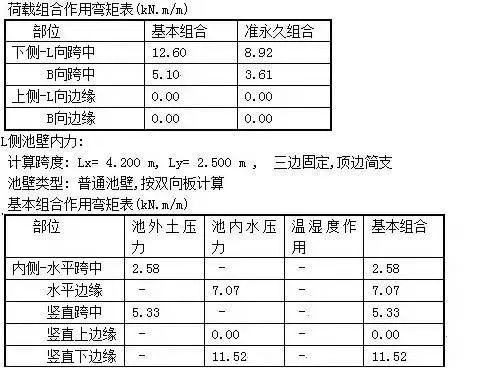(2)废水处理系统前格栅栅条间隙,应符合下列要求:最大间隙40mm,其中人工清除25~40mm,机械清除16~25mm。废水处理厂亦可设置粗、细两道格栅,粗格栅栅条间隙50~100mm。
(4)如泵前格栅间隙不大于25mm,废水处理系统前可不再设置格栅。
(1)栅渣量与多种因素有关,在无当地运行资料时,可以采用以下资料。
格栅间隙16~25mm;0.10~0.05m3/103m3(栅渣/废水)。
格栅间隙30~50mm;0.03~0.01m3/103m3(栅渣/废水)。
(2)栅渣的含水率一般为80%,容重约为960kg/m3。
(3)在大型废水处理厂或泵站前的大型格栅(每日栅渣量大于0.2m3),一般应采用机械清渣。
(2)格栅前渠道内水流速度一般采用0.4~0.9m/s。
(3)格栅倾角一般采用45°~75°,小角度较省力,但占地面积大。
(4)机械格栅的动力装置一般宜设在室内,或采取其他保护设备的措施。
(5)设置格栅装置的构筑物,必须考虑设有良好的通风设施。
(6)大中型格栅间内应安装吊运设备,以进行设备的检修和栅渣的日常清除。
二、格栅的设计计算

式中,S为栅条宽度,m;n为栅条间隙数,个;b为栅条间隙,m;为最大设计流量,m3/s;a为格栅倾角,(°);h为栅前水深,m,不能高于来水管(渠)水深;v为过栅流速,m/s。

式中,h0为计箅水头损失,m;k为系数,格栅堵塞时水头损失增大倍数,一般采用3;ζ为阻力系数,与栅条断而形状有关,按表2-1-1阻力系数ζ计箅公式计算;g为重力加速度,m/s2。


式中,L1为进水渠道渐宽部分的长度,m;L2为栅槽与出水渠道连接处的渐窄部分长度;H1为栅前渠道深,m;B1为进水渠宽,m;α1为进水渠道渐宽部分的展开角度,(°),一般可采用20。
式中,W1为栅渣量,m3/103m3废水,格栅间隙为16~25mm时,W1=0.10~0.05;格栅间隙为30~50mm时,W1=0.03~0.01;Kz为城市生活污水流量总变化系数。
水池结构自重Gc=G1+G2+G3=945.00kN
基底以上的覆盖土总重量Gt=Gt1+Gt2=279.50kN
基底以上的地下水总重量Gs=Gs1+Gs2=45.50kN
活荷载作用力总和Gh=Gh1+Gh2=119.00kN
基底面积:A=(L+2×t2)×(B+2×t2)=5.000×8.500=42.50m2
基底压强:Pk=(Gc+Gw+Gt+Gs+Gh)/A
=(945.00+721.50+279.50+45.50+119.00)/42.500=49.66kN/m2
rm=[1.000×(20.00-10)+2.000×18.00]/3.000
考虑地下水作用,取浮重度,r=20.00-10=10.00kN/m3
fa=fak+ηbγ(b-3)+ηdγm(d-0.5)
=100.00+0.00×10.00×(5.000-3)+1.00×15.33×(3.000-0.5)
Pk=49.66<fa=138.33kPa,地基承载力满足要求。
抗浮力Gk=Gc+Gt+Gs=945.00+279.50+45.50=1270.00kN
浮力F=(4.500+2×0.250)×(8.000+2×0.250)×1.000×10.0×1.00=425.00kN
Gk/F=1270.00/425.00=2.99>Kf=1.05,抗浮满足要求。
池顶板自重荷载标准值:P1=25.00×0.200=5.00kN/m2
Qt=1.20×P1+1.27×Ph=7.91kN/m2

池内底部水压力:标准值=25.00kN/m2,基本组合设计值=31.75kN/m2
Qb=(945.00×1.20+279.50×1.27+45.50×1.27+119.00×1.27×0.90)/42.500
Qbe=(945.00+279.50+45.50×1.00+1.50×36.000×0.40+10.00×6.500×0.40)/42.500
Q=39.59-0.300×25.00×1.20=30.59kN/m2
Qb=[4.500×8.000×1.50×1.27+945.00×1.20+(3.900×7.400×2.500)×10.00×1.27]/42.500
Q=49.86-(0.300×25.00×1.20+2.500×10.00×1.27)=9.11kN/m2
Qbe=[4.500×8.000×1.50×0.40+945.00+(3.900×7.400×2.500)×10.00]/42.500
Qe=39.72-(0.300×25.00+2.500×10.00)
3.池壁温湿度作用(池内外温差=池内温度-池外温度)
计算跨度:Lx=4.100m,Ly=7.600m,四边简支


计算跨度:Lx=7.700m,Ly=2.500m,三边固定,顶边简支

计算跨度:Lx=4.200m,Ly=7.700m,四边简支+池壁传递弯矩按双向板计算。
1、池外填土,池内无水时,荷载组合作用弯矩表(kN˙m/m)

按基本组合弯矩计算配筋,按准永久组合弯矩计算裂缝,结果如下:
顶板配筋及裂缝表(弯矩:kN.m/m,面积:mm2/m,裂缝:mm)

注:0.8是风机效率,是一个变数,0.98是一个机械效率也是一个变数(A型为1,D、F型为0.98,C、B型为0.95)
式中:P1=工况全压(Pa)、P2=设计标准压力(或表中全压Pa)、B=当地大气压(mmHg)、T2=工况介质温度℃、T1=表中或未修正的设计温度℃、760mmHg=在海拔0m,空气在20℃情况下的大气压。
(760mmHg)-(海拨高度÷12.75)=当地大气压(mmHg)







初沉池的来水通过DN1000mm的管道送入厌氧—缺氧—好氧曝气池首端的进水渠道,管道内的水流速度为0.84m/s。在进水渠道中污水从曝气池进水口流入厌氧段,进水渠道宽1.0m,渠道内水深为1.0m,则渠道内最大水流速度
V1=0.66/(2×1.0×1.0)=0.33m/s
v2——孔口流速(m/s),一般采用0.2~1.5m/s。

厌氧—缺氧—好氧池的出水采用矩形薄壁堰,跌落出水,堰上水头

Q——每座反应池出水量(m3/s),指污水最大流量(0.579m/s);与回流污泥量、回流量之和(0.717×160%m3/s);

厌氧—缺氧—好氧池的最大出水流量为(0.66+0.66/1.368×160%)=1.43m3/s,出水管管径采用DN1500mm,送往二沉池,管道内的流速为0.81m/s。



文章内容来源环保小蜜蜂、环保水圈,图片来源:环保水圈,转载平台:环保小蜜蜂微信,责任编辑胡静,审核人:李峥
版权声明∶转载流程工业网内容,请在正文上方注明来源和作者,且不得对内容作实质性改动;微信公众号、头条号等新媒体平台,转载请联系授权。邮箱∶process@vogel.com.cn,电话:16601379371(同微信)







































评论
加载更多